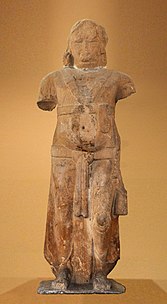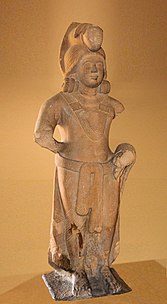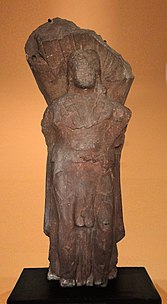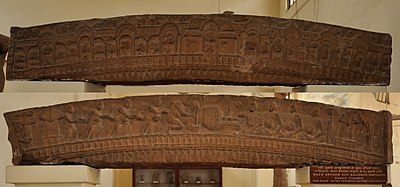Art of Mathura
| Art forms of India |
|---|
 |
| By religion |
| By period |
| By technique |
| By location |
| See also |
|
The Art of Mathura refers to a particular school of Indian art, almost entirely surviving in the form of sculpture, starting in the 2nd century BCE, which centered on the city of Mathura, in central northern India, during a period in which Buddhism, Jainism together with Hinduism flourished in India.[5] Mathura "was the first artistic center to produce devotional icons for all the three faiths",[6] and the pre-eminent center of religious artistic expression in India at least until the Gupta period, and was influential throughout the sub-continent.[7]
Chronologically, Mathuran sculpture becomes prominent after Mauryan art, the art of the Mauryan Empire (322 and 185 BCE).[8] It is said to represent a "sharp break" with the previous Mauryan style, either in scale, material or style.[8] Mathura became India's most important artistic production center from the second century BCE, with its highly recognizable red sandstone statues being admired and exported all over India.[8] In particular, it was in Mathura that the distinctive Indian convention of giving sacred figures multiple body parts, especially heads and arms, first became common in art around the 4th century CE, initially exclusively in Hindu figures, as it derived from Vedic texts.[6]
The art of Mathura is often contrasted with the Greco-Buddhist art of Gandhara, which developed from the 1st century CE.[8] In particular there is a debate about the origin of the Buddha image and the role played by each school of art. Before the creation of an image of the Buddha, probably around the 1st century CE, Indian Buddhist art, as seen in Bharhut or Sanchi, had essentially been aniconic, avoiding representation of the Buddha, but rather relying on its symbols, such as the Wheel of the Law or the Bodhi tree.
Mathura continued to be an important centre for sculpture until Gupta art of the 4th to 6th centuries, if not beyond. After this time much of the sculpture was of Hindu figures.
History[]
Early history[]

Some very early depictions of deities seem to appear in the art of the Indus Valley Civilisation, but the following millennium, coinciding with the Indo-Aryan migration during the Vedic period, is devoid of such remains.[9] It has been suggested that the early Vedic religion focused exclusively on the worship of purely "elementary forces of nature by means of elaborate sacrifices", which did not lend themselves easily to anthropomorphological representations.[10][11] Various artefacts may belong to the Copper Hoard Culture (2nd millennium CE), some of them suggesting anthropomorphological characteristics.[12] Interpretations vary as to the exact signification of these artifacts, or even the culture and the periodization to which they belonged.[12] Some examples of artistic expression also appear in abstract pottery designs during the Black and red ware culture (1450-1200 BCE) or the Painted Grey Ware culture (1200-600 BCE), with finds in a wide area, including the area of Mathura.[12]
Most of the early finds at Mathura correspond to what is called the "second period of urbanization" in the middle of the 1st millennium BCE, after a gap of about a thousand years following the collapse of the Indus Valley Civilisation.[12] The anthropomorphic depiction of various deities apparently started in the middle of the 1st millennium BCE, possibly as a consequence of the influx of foreign stimuli initiated with the Achaemenid conquest of the Indus Valley, and the rise of alternative local faiths challenging Vedism, such as Buddhism, Jainism and local popular cults.[9]
Mauryan period[]
Mathura seems to have been a comparatively unimportant city of central northern India during the period of the Maurya Empire (ca. 320-180 BCE), whose capital was in eastern India at Pataliputra, but it was still called a "great city" by Megasthenes.[13][8] Mauryan art and architecture flourished during that period in other cities such as Pataliputra, Kausambi, Vidisha or Amaravati, but there are no known examples of stone sculpture or architecture at Mathura that can be securely dated to the Mauryan period.[14][8] Excavations have shown that the first construction consisted in a mud wall, dating to the end of the Maurya period, around the 3rd century BCE at the earliest.[13] It seems Mathura only rose to prominence as a cultural and urban center around 150-100 BCE.[15]
Terracotta figurines (4th-2nd century BCE)[]

Although no stone sculpture or architecture from the Mauryan period are known in Mathura, some relatively high quality terracotta statuettes have been recovered from the Mauryan strata in excavations.[18] This would suggest that there was some level of artistic creation at Mathura during the period of the Maurya Empire.[18] The creation of terracotta figurines is thought to have been much easier than sculpting stone, and therefore became the mainstream form of artistic expression.[19] In Mathura, the first statuette were found in strata dating to the late 4th-2nd centuries BCE, and their production, together with associated terracotta miniatures of votive tanks and shrines, seems to have continued for close to a thousand years.[20]
Terracottas generally showed what appears to be female deities or mother goddesses, and from the 2nd century women in elaborate headdress.[19][21] The ancient Vedic text of the Shatapatha Brahmana describes such figurines as "broad-hipped, of smooth breast-region and slender waisted" and suggests that they are personifications of the earth, especially the earth goddesses Prithivi and Aditi, as "the container and supporter of the whole world", and the "repository of all Gods".[16] Their headdress is often decorated with lotus stalks, complete with conical lotus pistils with their seeds, which symbolize fecundity and beauty.[16] The lotus would remain an attribute of female deities in later periods.[16] Some terracotta statuettes also show a child or children clinging to the goddess, thereby emphasizing her role as a symbol of fecundity.[16] The cult of these female goddesses, characterized by small and easily manufactured figures, appears to have been essentially domestic.[20]
Several figures of foreigners also appear in the terracottas from the 4th and 3rd century BCE, which are either described simply as "foreigners" or Persian or Iranian because of their foreign features.[22][23][24] These figurines might reflect the increased contacts of Indians with Iranian people during this period.[23] Several of these seem to represent foreign soldiers who visited India during the Mauryan period and influenced modellers in Mathura with their peculiar ethnic features and uniforms.[25] One of the terracotta statuettes, a man nicknamed the "Persian nobleman" and dated to the 2nd century BCE, can be seen wearing a coat, scarf, trousers and a turban.[26][27][28][22]
Terracotta figurine production evolved with the adoption of moulds in the 3rd-2nd century BCE.[29][19]

Terracotta figurine, Mathura, 4th century BCE
Terracotta female coiffure, Mathura, 2nd century BCE
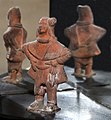
"Persian Nobleman clad in coat dupatta trouser and turban", Mathura, c. 2nd Century BCE.[22]
Early depictions of Indian deities (190-180 BCE)[]
The anthropomorphic depiction of various deities apparently started to appear in the middle of the 1st millennium BCE. Panini and Patanjali seem to mention depictions of Shiva, Skanda, Visaka, Vasudeva and Arjuna.[34] In particularly, the worship of Balarama-Samkarshana and Vāsudeva-Krishna seems to have originated in Mathura, where they were revered as members of the five Vrishni heroes, and spread from there.[35]
Before the introduction of stone sculpture, there may have been an older tradition of using clay or wood to represent Indian deities, which, because of their inherent fragility, have not survived.[36] Apart from the local terracotta figurines generally showing female fertility deities, there are no early remains of such representations of Indian deities. Probably the earliest known Indian depiction of these Mathuran deities is a rock painting found at Tikla, around 170 kilometers south of Mathura, on the road from Mathura to Tumain and Ujjain.[30] This rock painting is dated to the 3rd-2nd century BCE, based on the paleography of the Brahmi inscription accompanying it.[30] Here, the deities are depicted wearing a dhoti with a peculiar headdress, and are shown holding their attributes: a plow and a sort of mace for Balarama, and a mace and a wheel for Vāsudeva. A third smaller character is added, forming what can be called a Vrishni trio, in the person of a female, thought to be the Goddess Ekanamsha, who seems to hold a Chatra royal umbrella.[30]
The "earliest unambiguous" images of these deities, is an indirect testimony appearing with the coinage of the Indo-Greek king Agathocles, who issued coins with the image of Indian deities in Indian style, together with legends in the Greek and Brahmi scripts, circa 180-190 BCE.[33][32][37][31] The coins were probably issued in an area not far west of Mathura, if not in Mathura itself, since they depict Vāsudeva, whose cult was famous in Mathura, and employ the Brahmi script, which was in use in the region, rather than the northwestern Kharoshthi script.[38] The Indo-Greeks may have played a major role in breaking the Vedic tradition of representing deities through symbols only, rather than in human form, since Greek art did not have any such restrictions.[11]
The depictions of Indian deities, as witnessed by the Indo-Greeks transferred on their coinage, are generally thought to refer to Balarama-Samkarshana and Vāsudeva-Krishna, shown together with their rather unambiguous attributes, especially the Gada mace and the plow for the former, and the Vishnu attributes of the Shankha (a pear-shaped case or conch) and the Sudarshana Chakra wheel for the latter.[32][39] The worship of these deities is known to have originated in Mathura before spreading to other areas of India,[35][38] especially since Krishna and his brother Balarama were born in Mathura to the Vrishni king Vasudeva Anakadundubhi.[40] It is thought that local Indian images, predating the coins but now lost, may have served as models to the engravers.[39] According to Osmund Bopearachchi, the parasol-like headdress of these deities is actually a misrepresentation of a shaft with a half-moon parasol on top (chattra), as seen in later statues of Bodhisattvas in Mathura.[39] Although the style is generally Indian, the boots or the scabbards may have been added by the Indo-Greeks.[31] The heads of the deities are also adorned with billowing ribons.[31]
A dancing goddess in Indian dress also appears on the coinage of Agathocles and Pantaleon, and she is often interpreted as Lakshmi.[32] According to Harry Falk, such acts of devotion towards foreign gods, as can also be seen in the dedication of the Heliodorus pillar, was a logical practice for the Greeks, in order to appropriate the power of local deties: it "should not be regarded as a "conversion" to Hinduism, but rather as the result of a search for the most helpful local powers, upholding own traditions in a foreign garb."[41]
Early stone sculpture in Mathura (180-70 BCE)[]
The period after 180 BCE has generally been called the "Sunga period", from the name of the Hindu Sunga Empire (c. 180-80 BCE) which replaced the Mauryan Empire in eastern India. This is now thought to be rather inadequate since the Sungas probably never ruled in Mathura: there is no literary, numismatic or epigraphic evidence of a Sunga presence in Mathura.[43]
Following the demise of the Mauryan Empire and its replacement by the Sunga Empire in eastern India, numismatic, literary and epigraphic evidence suggest that the Indo-Greeks, when they invaded India, occupied the area of Mathura for about a century from circa 160 BCE and the time of Menander I until approximately 60 BCE, with the Sungas remaining eastward of Mathura.[42][8] An inscription in Mathura discovered in 1988,[44][45] the "Yavanarajya inscription", mentions "The last day of year 116 of Yavana hegemony (Yavanarajya)", suggesting the presence of the Indo-Greeks in the 2nd-1st century BC in Mathura down to 57 BC.[42] On the contrary, the Sungas, are thought to have been absent from Mathura, as no epigraphical remains or coins have been found, and to have been based to the east of the Mathura region.[42] Coins of local Indian rulers of the Mitra dynasty, their names ending in "-mitra", but not using any regnal title such as "King", are also known from the same period and general area (150-50 BCE, mostly in the area of Sonkh), and were possibly engaged in a tributary relationship with the Indo-Greeks.[46][47]
Stone art and architecture began being produced at Mathura at the time of "Indo-Greek hegemony" over the region.[48][8] Some authors consider that Indo-Greek cultural elements are not particularly visible in these works, and Hellenistic influence is not more important than in other parts of India.[49] Others consider that Hellenistic influence appears in the liveliness and the realistic details of the figures (an evolution compared to the stiffness of Mauryan art), the use of perspective from 150 BCE, iconographical details such as the knot and the club of Heracles, the wavy folds of the dresses, or the depiction of bacchanalian scenes:[8][50]
150-100 BCE
"Mathura sculpture is distinguished by several qualitative features of art, culture and religious history. The geographical position of the city on the highway leading from the Madhyadesa towards Madra-Gandhara contributed in a large measure to the eclectic nature of its culture. Mathura became the meeting ground of the traditions of the early Indian art of Bharhut and Sanchi together with strong influences of the Iranian and the Indo-Bactrian or the Gandhara art from the North-West. The Persepolitan capitals with human-headed animal figures and volutes as well as the presence of the battlement motif as a decorative element point to Iranian affinities. These influences came partly as a result of the general saturation of foreign motifs in early Indian sculpture as found in the Stupas of Bharhut and Sanchi also."
— Vasudeva Shrarana Agrawala, Masterpieces of Mathura sculpture[58]
The art of Mathura became extremely influential over the rest of India, and was "the most prominent artistic production center from the second century BCE".[8] There is a remarkable unity in the style of artistic production across northern India during this early period, circa 150 BCE: the early style of Mathura is highly similar to contemporary examples found in Bharhut, Sanchi Stupa No. 2, Vidisha, Bhaja, Pauni, Amaravati, Jaggayyapeta, Bhubaneswar, Udayagiri (in Orissa), Pataliputra, Sarnath, Bhīta (near Allahabad)[59] and Kausambi.[60]
Colossal anthropomorphic statues (2nd century BCE)[]
Some of the earliest works of art of the Mathura school are the Yakshas, monumental sculptures in the round of earth divinities that have been dated to the 2nd-1st century BCE. Yakshas seem to have been the object of an important cult in the early periods of Indian history, many of them being known such as Kubera, king of the Yakshas, Manibhadra or Mudgarpani.[61] The Yakshas are a broad class of nature-spirits, usually benevolent, but sometimes mischievous or capricious, connected with water, fertility, trees, the forest, treasure and wilderness,[62][63] and were the object of popular worship.[64] Many of them were later incorporated into Buddhism, Jainism or Hinduism.[61]
In the 2nd century BCE, Yakshas became the focus of the creation of colossal cultic images, typically around 2 meters or more in height, which are considered as probably the first Indian anthropomorphic productions in stone.[50][61] The colossal size and quality of these statues shows that they cannot just have been the object of a rural popular cult, but were rather produced in urban workshops and worshipped in shrines by an affluent urban community.[65] Although few ancient Yaksha statues remain in good condition, the vigor of the style has been applauded, and expresses essentially Indian qualities.[50] They are often pot-bellied, two-armed and fierce-looking.[61] The Parkham Yaksha, dated to circa 150 BCE on stylistic grounds and paleographical grounds, is monumental at 2.59 meters high.[66][67][68] An inscription says "Made by Gomitaka, a pupil of Kunika. Set up by eight brothers, members of the Manibhadra congregation ("puga")." This inscription thus indicates that the statue represents the Yaksa Manibhadra.[69] The Yashas are often depicted with weapons or attributes, such as the Yaksha Mudgarpani, dated circa 100 BCE, who in the right hand holds a mudgar mace, and in the left hand the figure of a small standing devotee or child joining hands in prayer.[52][61] It is often suggested that the style of the colossal Yaksha statuary had an important influence on the creation of later divine images and human figures in India.[36] The female equivalent of the Yashas were the Yashinis, often associated with trees and children, and whose voluptuous figures became omnipresent in Indian art.[61]
Some Hellenistic influence, such as the geometrical folds of the drapery or the contrapposto walking stance of the statues, has been suggested.[50] According to John Boardman, the hem of the dress in the monumental early Yaksha statues is derived from Greek art.[50] Describing the drapery of one of these statues, John Boardman writes: "It has no local antecedents and looks most like a Greek Late Archaic mannerism", and suggests it is possibly derived from the Hellenistic art of nearby Bactria where this design is known.[50] Under the Indo-Greeks, the cult of the Yakshas may also have been associated with the Bacchic cult of Dionysos.[70] Since the time of Alexander the Great visiting a city called Nysa in northern India, the Greeks had identified local devotional practices as similar to their cult of Dionysos.[71] They may have promoted a syncretic art which conflated Hellenistic Dionysiac imagery with the local cult of the Yakshas.[72]
In the production of colossal Yaksha statues carved in the round, which can be found in several locations in northern India, the art of Mathura is considered as the most advanced in quality and quantity during this period.[73] In later periods, from the turn of the millennium, Yashkas and Nagas evolved from being benevolent, powerful deities at the center of worship, to becoming frightening demonic creatures acting as subsidiary attendants in the major religions of Buddhism, Jainism and Hinduism.[65] They also became much smaller in size as they were dethroned by the new religions, suggesting the continuation of a cult at the domestic level.[65]
Simple reliefs (circa 150-100 BCE)[]
Various reliefs in a style similar to those of Bharhut or Sanchi Stupa No. 2 can be found in Mathura, dating to approximately 150-100 BCE.[76] A dedicatory inscription by Dhanabhuti at Mathura records the donation of railings and a gateway to the Buddhists samgha.[43][77] It is now lost.[78] The Dhanabhuti in the Mathura inscription could be the same person as King Dhanabhuti in the Bharhut inscription, about 322 kilometers away, and this could suggest some cultural, religious and artistic connection between the two areas.[60][79] Reliefs are usually rather simple and consist in medallions on railings or balusters, structural elements of stone barriers or "vedikas" probably established around large stupas which have not remained to this day.[80]
The "Mehrauli Yakshi", one of the highest quality work among early sculpture, was found in Mehrauli in the cultural area of Mathura.[81] The high-relief and skillfully carved sculpture shows a female nature divinity, called a Yakshini, holding on the branches of a tree in the Salabhanjika pose, with a long double braid of hair descending down to the girdle.[75][81] The sculpture probably used to adorn the railing of a sacred site, such as a Stupa.[81] She is dated to 150 BCE, and prefigures by more than a century the Salabhanjika Yakshinis of Sanchi.[82][75][81] It is at the same time one of the most artistically beautiful and earliest of the Yakshi sculptures, with detailed patterning contrasting with the smoothness of the skin, standing at the beginning of a long tradition of Yashi sculptures in Mathura and India as a whole.[81] There are many similarities with the Yakshis found in Bharhut, although the Mehrauli Yakshi has rounder volumes, characteristic of the Mathura style and technical proficiency in carving.[81]
Some other sculpted figures also are dated to circa 150 BCE, due to their similarity with equivalent figures in Bharhut. This is the case of a male Chauri-bearer with its sharp lines and stiff expression, held at the Mathura Museum.[83] Sir John Marshall considered the early reliefs of Mathura and Bharhut as part of the same tradition, calling it the "Bharhut-Mathura School", while the reliefs of Sanchi were a second tradition, calling it the "Malwa School of Sanchi".[84]

Crossbar medallion with elephant and riders, Gayatri Tila, Mathura, circa 150 BCE.[85]
Crossbar with female head in lotus medallion, circa 2nd Century BCE, Mathura.[88]

Buddhist railing with Bodhi tree and Wheel of Law. 1st century BCE
Railing crossbars, 2nd-1st century BCE.
Crossbar medallion with horse rider. 2nd-1st century BCE.
Complex narrative reliefs (circa 100 BCE)[]

By 100 BCE, the reliefs represent more complex scenes, defining, according to Sonya Rhie Quintanilla, an age of "iconic diversification and narrative maturation", as shown by the Kankali Tila architrave representing centaurs worshipping a Jain stupa, the dance of Nilanjana, and the renunciation of Rsabhanata, or the Katra architrave representing Brahmins with pots in a sacred precinct.[91][92] Another relief from the same period shows a Linga inside a railing on platform and under a pipal tree, being worshipped by Gandharvas, an early depiction of the phallic cult in Shivaism.[90]
Several of these reliefs are the first known examples of Jain sculpture.[93] These reliefs show more depth, and a greater richness in their composition.[92] These examples of narrative reliefs, although few remain, are as refined and intricate as the better known narrative reliefs of Bharhut, Sanchi or Amaravati.[94][92] The centaurs appearing in the Mathura reliefs, as in other places such as Bodh Gaya, are generally considered as Western borrowings.[95]
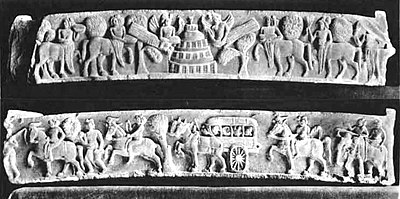
Kankali Tila architrave with Centaurs worshipping a Jain Stupa, Mathura, circa 100 BCE[96]
Indo-Scythian period (circa 60 BCE-90 CE)[]

From around 70 BCE, the region of Mathura fell to the Indo-Scythian Northern Satraps under Hagamasha, Hagana and then Rajuvula.[46] During this time, Mathura is described as "a great center of Śaka culture in India".[102] Little is known precisely from that period on terms of artistic creation. The Indo-Scythian Rajuvula, ruler of Mathura, created coins which were copies of the contemporary Indo-Greek ruler Strato II, with effigy of the king and representation of Athena on the obverse.[101] Indo-Scythians are known to have sponsored Buddhism, but also other religions, as visible from their inscriptions and archaeological remains in northwestern and western India, as well as from their contributions to pre-Kushana sculpture in Mathura.[103]
End of 1st century BCE[]
Some works of art dated to the end of the 1st century BCE show very delicate workmanship, such as the sculptures of Yakshis.[104] A the very end of this period the Indo-Scythian ruler Rajuvula is also known for the famous Mathura lion capital which records events of the Indo-Scythian dynasty as well as their support of Buddhism. It is also an interesting example of the state of artistic attainment in the city of Mathura at the turn of our era. The capital portrays two lions reminiscent of the lions of the Pillars of Ashoka, but in a much cruder style. It also displays at its center a Buddhist triratana symbol, further confirming the involvement of Indo-Scythian rulers with Buddhism. The triratna is contained in a flame palmette, an element of Hellenistic iconography, and an example of Hellenistic influence on Indian art.[105]
The fact that the Mathura lion capital is inscribed in Kharoshthi, a script used in the far northwest around the area of Gandhara, attests to the presence of northwestern artists at that time in Mathura.[106]

Yashi with onlookers, dated 20 BCE.[107]

Yashi with onlookers (detail), dated 20 BCE.

Yashi with onlookers (detail), dated 20 BCE.

Yashi with onlookers (detail), dated 20 BCE.
Mathura sculpture styles in the 1st century CE[]
The abundance of dedicatory inscriptions in the name of Sodasa, the Indo-Scythian ruler of Mathura, and son of Rajuvula (eight such inscriptions are known, often on sculptural works),[108] and the fact that Sodasa is known through his coinage as well as through his relations with other Indo-Scythian rulers whose dates are known, means that Sodasa functions as a historic marker to ascertain the sculptural styles at Mathura during his rule, in the first half of the 1st century CE.[109][105] These inscriptions also correspond to some of the first known epigraphical inscriptions in Sanskrit.[110][111] The next historical marker corresponds to the reign of Kanishka under the Kushans, whose reign began circa 127 CE.[109] The sculptural styles at Mathura during the reign of Sodasa are quite distinctive, and significantly different from the style of the previous period circa 50 BCE, or the styles of the later period of the Kushan Empire in the 2nd century CE.[109]
In-the-round statuary[]
Several examples of in-the-round statuary have been found from the period of Sodasa, such as the torsos of "Vrishni heroes", discovered in Mora, about 7 kilometers west of Mathura.[118] These statues are mentioned in the Mora Well Inscription nearby, made in the name of the Northern Satraps Sodasa circa 15 CE, in which they are called Bhagavatam.[119][120][121] The statue fragments are thought to represent some of the five Vrishni heroes, possibly ancient kings of Mathura later assimilated to Vishnu and his avatars,[114][122] or, equally possible, the five Jain heroes led by Akrūra, which are well attested in Jain texts.[118] In fact, the cult of the Vrishnis may have been cross-sectarian, much like the cult of the Yakshas.[118]
The two uninscribed male torsos that were discovered are both of high craftsmanship and in Indian style and costume.[122] They are bare-chested but wear a thick necklace, as well as heavy hearrings.[118] The two torsos that were found are similar with minor variations, suggesting they may have been part of a series, which is coherent with the Vrishni interpretation.[116] They share some sculptural characteristics with the Yaksha statues found in Mathura and dating to the 2nd and 1st century BCE, such as the sculpting in the round, or the clothing style, but the actual details of style and workmanship clearly belong to the time of Sodasa.[118][114] The Vrishni statues also are not of the colossal type, as they would only have stood about 1.22 meters complete.[118] The Mora Vrishnis function as an artistic benchmark for in-the-round statues of the period.[118]
1st Jaina Tirthankara Rishabhanatha torso - Circa 1st Century
Four-fold Jain image with Suparshvanath and three other Tirthankaras - Circa 1st Century CE
Goat-headed Jain Mother Goddess, circa 1st Century CE
Jain reliefs[]
Many of the sculptures from this period are related to the Jain religion, with numerous relief showing devotional scenes, such as the Kankali Tila tablet of Sodasa in the name of Sodasa.[109] Most of these are votive tablets, called ayagapata.[123]
Jain votive plates, called "Ayagapatas", are numerous, and some of the earliest ones have been dated to circa 50-20 BCE.[124] They were probably prototypes for the first known Mathura images of the Buddha.[125] Many of them were found around the Kankali Tila Jain stupa in Mathura.
Notable among the design motifs in the ayagapatas are the pillar capitals displaying "Persian-Achaemenian" style, with side volutes, flame palmettes, and recumbent lions or winged sphinxes.[126][127]

Jain votive plaque with Jain stupa, the "Vasu Śilāpaṭa" ayagapata, 1st century CE, excavated from Kankali Tila, Mathura.[131]

Jain relief showing monks of the ardhaphalaka sect. Early 1st century CE.[132]
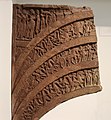
Jain decorated tympanum from Kankali Tila, Mathura, 15 CE.[133]

"Persian Achaemenian" style capitals appearing in ayagapatas, Mathura, 15-50 CE.[134][135][136]

Sivayasa Ayagapata, with Jain stupa fragment, Kankali Tila, 75-100 CE.
Grapevine and garland designs (circa 15 CE)[]
A decorated doorjamb, the Vasu doorjamb, dedicated to deity Vāsudeva, also mentions the rule of Sodasa, and has similar carving to the Mora doorjamb, found in relation with the Mora well inscription in a similar chronological and religious context. The decoration of these and many similar doorjambs from Mathura consists in scrolls of grapevines. They are all dated to the reign of Sodasa, circa 15 CE and constitute a secure dated artistic reference for the evaluation of datation of other Mathura sculptures.[117] It has been suggested that the grapevine design had been introduced from the Gandhara area in the northwest, and maybe associated with the northern taste of the Satrap rulers.[138] These designs may also be the result of the work of northern artists in Mathura.[138] The grapevine designs of Gandhara are generally considered as originating from Hellenistic art.[139]

The Vasu doorjamb, dedicated to Vāsudeva "in the reign of Sodasa", Mathura, circa 15 CE. Mathura Museum, GMM 13.367[117]

Reliefs of the Mora doorjamb with grapevine design, Mora, near Mathura, circa 15 CE. State Museum Lucknow, SML J.526.[117] Similar scroll designs are known from Gandhara, from Pataliputra, and from Greco-Roman art.
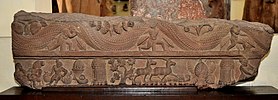
Garland bearers and Buddhist "Romaka" Jataka, in which the Buddha in a previous life was a pigeon.[140] 25-50 CE.[141] Similar garland-bearer designs are known from Gandhara, from Amaravati and from Greco-Roman art.
Calligraphy (end 1st century BCE - 1st century CE)[]
The calligraphy of the Brahmi script had remained virtually unchanged from the time of the Maurya Empire to the end of the 1st century BCE.[143] The Indo-Scythians, following their establishment in northern India introduced "revolutionary changes" in the way Brahmi was written.[143] In the 1st century BCE, the shape of Brahmi characters became more angular, and the vertical segments of letters were equalized, a phenomenon which is clearly visible in coin legends and made the script visually more similarly to Greek.[143] In this new typeface, the letter were "neat and well-formed".[143] The probable introduction of ink and pen writing, with the characteristic thickenned start of each stroke generated by the usage of ink, was reproduced in the calligraphy of stone inscriptions by the creation of a triangle-shaped form at the beginning of each stroke.[143][146] This new writing style is particularly visible in the numerous dedicatory inscriptions made in Mathura, in association with devotional works of art.[143] This new calligraphy of the Brahmi script was adopted in the rest of the subcontinent of the next half century.[143] The "new-pen-style" initiated a rapid evolution of the script from the 1st century CE, with regional variations starting to emerge.[143]
First images of the Buddha (from circa 15 CE)[]

From around the 2nd-1st century BCE at Bharhut and Sanchi, scenes of the life of the Buddha, or sometimes of his previous lives, had been illustrated without showing the Buddha himself, except for some of his symbols such as the empty throne, or the Chankrama pathway.[148] This artistic device ended with the sudden appearance of the Buddha, probably rather simultaneously in Gandhara and Mathura, at the turn of the millennium.[148]
Possibly the first known representation of the Buddha (the Bimaran casket and the Tillya Tepe Buddhist coin are other candidates), the "Isapur Buddha" is also dated on stylistic grounds to the reign of Sodasa, circa 15 CE; he is shown on a relief in a canonical scene known as "Lokapalas offer Alms Bowls to the Buddha Sakyamuni".[149] The symbolism of this early statue is still tentative, drawing heavily on the earlier, especially Jain, pictural traditions of Mathura, still far from the exuberant standardized designs of the Kushan Empire.[149] It is rather unassuming and not yet monumental compared to the Buddha sculptures of the following century, and may represent one of the first attempts to create a human icon, marking an evolution from the splendid aniconic tradition of Buddhist art in respect to the person of the Buddha, which can be seen in the art of Sanchi and Bharhut.[149] This depiction of the Buddha is highly similar to Jain images of the period, such as the relief of Jina Parsvanatha on an ayagapata, also dated to circa 15 CE.[137][128]
It is thought that the images of Jain saints, which can be seen in Mathura from the 1st century BCE, were prototypes for the first Mathura images of the Buddha, since the attitudes are very similar, and the almost transparent very thin garment of the Buddha not much different visually from the nakedness of the Jinas.[125] Here the Buddha is not wearing the monastic robe which would become characteristic of many of the later Buddha images.[125] The cross-legged sitting posture may have derived from earlier reliefs of cross-legged ascetics or teachers at Bharhut, Sanchi and Bodh Gaya.[150] It has also been suggested that the cross-legged Buddhas may have derived from the depictions of seated Scythian kings from the northwest, as visible in the coinage of Maues (90-80 BCE) or Azes (57-10 BC).[150]
There has been a recurring debate about the exact identity of these Mathura statues, some claiming that they are only statues of Bodhisattavas, which is indeed the exact term used in most of the inscriptions of the statues found in Mathura. Only one or two statues of the Mathura type are known to mention the Buddha himself.[151] This could be in conformity with an ancient Buddhist prohibition against showing the Buddha himself in human form, otherwise known as aniconism in Buddhism, expressed in the Sarvastivada vinaya (rules of the early Buddhist school of the Sarvastivada): ""Since it is not permitted to make an image of the Buddha's body, I pray that the Buddha will grant that I can make an image of the attendant Bodhisattva. Is that acceptable?" The Buddha answered: "You may make an image of the Bodhisattava"".[152] However the scenes in the Isapur Buddha and the later Indrasala Buddha (dated 50-100 CE), refer to events which are considered to have happened after the Buddha's enlightenment, and therefore probably represent the Buddha rather than his younger self as a Bodhisattava, or a simple attendant Bodhisattva.[153]
Other reliefs[]

The Buddhist "Indrasala architrave", dated 50-100 CE, with a scene of the Buddha at the Indrasala Cave being attended by Indra, and a scene of devotion to the Bodhi Tree on the other side, is another example of the still hesitant handling of the human icon of the Buddha in the Buddhist art of Mathura.[154] The Buddhist character of this architrave is clearly demonstrated by the depiction of the Bodhi Tree inside its specially built temple at Bodh Gaya, a regular scene of Buddhism since the reliefs of Bharhut and Sanchi.[154] The depiction of the Buddha in meditation in the Indrasala Cave is also characteristically Buddhist.[154] The Buddha already has the attributes, if not the style, of the later "Kapardin" statues, except for the absence of a halo.[3]

Vedic deities[]
Besides the hero cult of the Vrishni heroes or the cross-sectarian cult of the Yakshas, Hindu art only started to develop fully from the 1st to the 2nd century CE, and there are only very few examples of artistic representation before that time.[156] The three Vedic gods Indra, Brahma and Surya were actually first depicted in Buddhist sculpture, as attendants in scenes commemorating the life of the Buddha, even when the Buddha himself was not yet shown in human form but only through his symbols, such as the scenes of his Birth, his Descent from the Trāyastriṃśa Heaven, or his retreat in the Indrasala Cave.[156] These Vedic deities appear in Buddhist reliefs at Mathura from around the 1st century CE, such as Indra attending the Buddha at Indrasala Cave, where Indra is shown with a mitre-like crown, and joining hands.[156]
Early "Kapardin" statuary (end of 1st century CE)[]
The earliest types of "Kapardin" statuary (named after the "kapardin", the characteristic tuft of coiled hair of the Buddha) showing the Buddha with attendants are thought to be pre-Kushan, dating to the time of the "Kshatrapas" or Northern Satraps.[3] Various broken bases of Buddha statues with inscriptions have been attributed to the Kshatrapas.[3] A fragment of such a stele was found with the mention of the name of the donor as a "Kshatrapa lady" named Naṃda who dedicated the Bodhisattva image "for the welfare and happiness of all sentient beings for the acceptance of the Sarvastivadas", and it is considered as contemporary with the famous "Katra stele".[3][158]
One of these early examples shows the Buddha being worshipped by the Gods Brahma and Indra.[3]
The famous "Katra Bodhisattava stele" is the only fully intact image of a "Kapardin" Bodhisattva remaining from the Kshatrapa period, and is considered as the foundation type of the "Kapardin" Buddha imagery, and is the "classical statement of the type".[3]
In conclusion, the canonical type of the seated Bodhisattva with attendants commonly known as the "Kapardin" type, seems to have developed during the time the Indo-Scythian Northern Satraps were still ruling in Mathura, before the arrival of the Kushans.[159] This type continued during the Kushan period, down to the time of Huvishka, before being overtaken by fully-dressed types of Buddha statuary depicting the Buddha wearing the monastic coat "Samghati".[159]
Kushan period (ca. 90-300 CE)[]
Mahārāja Rājadhirāja Devaputra Kāṇiṣka
"The Great King, King of Kings, Son of God, Kanishka".[160][161]
Mathura Museum
Mathura became part of the Kushan Empire from the reign of Vima Kadphises (90-100 CE) and then became the southern capital of the Kushan Empire. Free-standing statues of the Buddha are mass-produced around this time, possibly encouraged by doctrinal changes in Buddhism allowing to depart from the aniconism that had prevailed in the Buddhist sculptures at Mathura, Bharhut or Sanchi from the end of the 2nd century BCE.[162] The Greco-Buddhist art of Gandhara appears to have fully developed around this time too, also under the rule of the Kushans, following on earlier imagery such as the Bimaran casket or the Butkara seated Buddha at the Butkara Stupa in Swat.[162] In 2008 a second sculpture in the distinctive Mathura red sandstone was excavated at Taxila in Gandhara (modern Pakistan).[163]
Dynastic art of the Kushans in Mathura[]
The Kushans vigorously promoted royal portraiture, as can be seen in their dynastic sculptures from Bactria to the region of Mathura.[164] Monumental sculptures of Kushan rulers, particularly Vima Kadphises and Kanishka I has been found in the ruins of the Temple of Mat in Mathura. The statues are characterized by their frontality and martial stance, with Kanishka being shown holding firmly his sword and a huge mace.[164] They are wearing heavy coats and heavy riding boots typical of the clothing of Central Asian nomads at that time, irrespective of the warm climate of India.[164] The coats are richly decorated with hundreds of pearls, which probably symbolize wealth.[164] These grandiose displays of Kushan dynastic power were accompanied by surperlative regnal titles: the statue of Kanishka is inscribed in Brahmi script with the sentence "The Great King, King of Kings, Son of God, Kanishka".[161][164]
To some extent, as the Kushans progressively adapted to life in India, their dress progressively became lighter, and representation less frontal and more natural, although they generally retained characteristic elements of their nomadic dress, such as the trousers and boots, the heavy tunics, and heavy belts.

Monumental statue of Vima Kadphises, 1st century CE, Mathura Museum
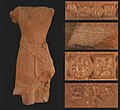
Statue of the Saka Prince Chastana, with costume details. 2nd century CE. Mathura Museum

Kushan devotee, Mathura Museum

Saka or Kushan Prince in pointed cap. Mathura Museum
"Kapardin" Bodhisattva statuary (2nd century CE)[]
("Year 4 of the Great King Kanishka")









